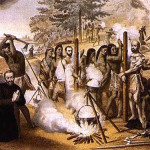Did the Accounts of Jesus Evolve?
by Joe Heschmeyer
Filed under Historicity
Biblical skeptics often surmise that the earliest New Testament books tell a very different story than the later books: that the story of Jesus grew with time, becoming more and more incredible, and less and less historical. In other words, the New Testament evolved from history to religious mythology.
Recently, I've seen this argument raised about both the Resurrection and the divinity of Christ. First, retired Episcopal Bishop John Shelby Spong (who denies the Resurrection) attacked the historicity of the Gospels, and in particular, the Resurrection account. He makes extensive recourse to the evolving-Bible:
"If we line up the gospels in the time sequence in which they were written - that is, with Mark first, followed by Matthew, then by Luke and ending with John - we can see exactly how the story expanded between the years 70 and 100.[...] In the first gospel, Mark, the risen Christ appears physically to no one, but by the time we come to the last gospel, John, Thomas is invited to feel the nail prints in Christ’s hands and feet and the spear wound in his side."
Second, a commenter on my own blog recently said in response to C.S. Lewis' “Lord, liar, lunatic” trilemma,
"That was clearly on the assumption that the gospel of John represents actual history because only in John does he claim to be God. Based simply on the Synoptic gospels, we can say that if Jesus is not God he can still be considered a good man or a moral teacher. C.S. Lewis' false-dilemma require absolute faith in John to work."
Yet we know John doesn't belong with the other gospels, or at least that it isn't as historical as they are. Aside from John alone making Jesus claim to be God, we see how it disagrees on how, when, and where Jesus called his disciples. Is there any merit to either of these evolving Bible claims? Let's look at each one in turn.
The Resurrection
Bishop Spong, in his CNN article, stacks the deck in two different ways. First, he focuses just on the Gospels, rather than the New Testament as a whole. Second, he claims that in Mark's Gospel, “the risen Christ appears physically to no one.”
The reality is that the earliest New Testament documents describe Christ as (a) physically Resurrected, and (b) appearing to innumerable people. In St. Paul's first letter to the Corinthians, he writes (1 Cor. 15:3-20),
"For I delivered to you as of first importance what I also received, that Christ died for our sins in accordance with the scriptures, that he was buried, that he was raised on the third day in accordance with the scriptures, and that he appeared to Cephas, then to the twelve. Then he appeared to more than five hundred brethren at one time, most of whom are still alive, though some have fallen asleep. Then he appeared to James, then to all the apostles.
Last of all, as to one untimely born, he appeared also to me. For I am the least of the apostles, unfit to be called an apostle, because I persecuted the church of God. But by the grace of God I am what I am, and his grace toward me was not in vain. On the contrary, I worked harder than any of them, though it was not I, but the grace of God which is with me. Whether then it was I or they, so we preach and so you believed.
Now if Christ is preached as raised from the dead, how can some of you say that there is no resurrection of the dead? But if there is no resurrection of the dead, then Christ has not been raised; if Christ has not been raised, then our preaching is in vain and your faith is in vain. We are even found to be misrepresenting God, because we testified of God that he raised Christ, whom he did not raise if it is true that the dead are not raised. For if the dead are not raised, then Christ has not been raised.
If Christ has not been raised, your faith is futile and you are still in your sins. Then those also who have fallen asleep in Christ have perished. If for this life only we have hoped in Christ, we are of all men most to be pitied. But in fact Christ has been raised from the dead, the first fruits of those who have fallen asleep."
So St. Paul tells us that Christ physically rose from the dead. He banks everything on the reality of the Resurrection: if it's not true, the Apostles are liars, Christians are pathetic, and the Gospel is proclaimed in vain. To validate this claim that Christ physically rose from the dead, Paul appeals to numerous post-Resurrection appearances, apparently well known to his Corinthian audience: Jesus appeared to Peter (Cephas), to the Twelve, to a group of five hundred brethren, and then to St. Paul himself.
In other words, Paul's not just saying, “the Tomb is empty, Jesus must have risen!” but that he had actually seen the Resurrected Christ, as had numerous others, many of whom were still alive and could vouch for this testimony.
Why does this matter? Well, Spong himself dates this passage from First Corinthians to the mid-50s, decades before when he thinks any of the Gospels were written. You can see this on page 201 of his book The Sins of Scripture. This completely destroys his claim that the earliest Resurrection accounts didn't have any post-Resurrection appearances, and that these were added “between the years 70 and 100.” What does Spong do in response? He simply ignores Paul's writings, and focuses on the Gospels alone.
Here, we get to the second way that he stacks the deck. He claims that in Mark's Gospel, “the risen Christ appears physically to no one.” The truth is that there's controversy over whether or not Mark 16:9-20 are part of Mark's original Gospel, because some of the earliest manuscripts don't include this passage. There are three theories:
- Mark 16:9-20 was written by Mark, but the section was lost in an early manuscript (and any manuscripts copied from that one).
- Mark originally had a different ending, which was lost; Mark 16:9-20 was appended to replace it.
- Mark originally ended his Gospel at Mark 16:8; Mark 16:9-20 is a later addition.
Spong assumes theory #3 is true, without actually telling his readers he's doing this, or justifying this choice.
But even if theory #3 is true, that doesn't mean that Mark denied post-Resurrection appearances. It would just mean that he stopped his Gospel quite abruptly at the empty Tomb on Easter morning. More likely, such an abrupt ending would be a way to begin an in-person dialogue: that readers would ask whoever gave them a copy of the Gospel what had happened at the Empty Tomb.
So Spong's suggestion that Mark was unaware of any post-Resurrection appearances doesn't follow at all. At most (and this is assuming theory # 3 is true), we can say simply that the post-Resurrection appearances postdated the events he's describing in his Gospel. Likewise, it's not unusual that the Gospels don't record details about Pentecost or the life of the early Church, or that Churchill biographies don't record details about the life of Thatcher. These things are simply outside of the scope of the work. Again, this is true only if Mark really did end his Gospel abruptly in verse 8, which is by no means certain.
So it's not clear that Mark's Gospel originally ended at verse 8, and there's no reason to believe in any case that he was unaware of post-Resurrection appearances. On the contrary, the earliest New Testament evidence is quite clear about the post-Resurrection appearances. Paul, who predates Mark, writes quite clearly about specific post-Resurrection appearances, as do Matthew (Mt. 28:9-10, Mt. 28:16-20), Luke (Lk. 24:13-53; Acts 1:1-11), and John (Jn. 20:10-11:25).
Of these, the one who lists the most post-Resurrection appearances is actually St. Paul. So this bears none of the marks of a big fish story that gets progressively larger over time. Everyone writing after Paul simply fleshes out specific accounts that he mentions in passing.
Jesus' Divinity
What about the claim that only John's Gospel depicts Christ as claiming to be Divine? Fr. Robert Barron debunks this claim pretty exhaustively, noting that when Christ claims to be greater than the Temple (Mt. 12:6), and to have the ability to forgive sins (Mark 2:5; Mk. 2:10), He's making claims that a Jewish audience would recognize as claims to Divinity (as they do: Mark 2:7). Likewise when He declares, “The Son of Man is Lord of the Sabbath” (Luke 6:5; Mk. 2:28).
But I want to take this in a slightly different direction, instead. Let's look at just the Gospel of Matthew, for now. In Matthew 2, the Magi come to worship the Christ Child (see Mt. 2:2, Mt. 2:11). Various other people worship Christ throughout this Gospel as well: a leper (Mt. 8:2), “a certain ruler” (Mt. 9:18), a Canaanite woman (Mt. 15:25), the mother of James and John (Mt. 20:20), the disciples who witnessed Jesus walking on water (Mt. 14:33), the women who see the Resurrected Christ (Mt. 28:9), and many members of the crowd to which He appears in Mt. 28:9. In exactly none of these cases does Jesus “correct” the acts, which, if mistaken about His Divinity, would be blasphemous.
So even if Jesus is being ambiguous in what He's claiming about Himself, we see innumerable people taking this as a declaration that He's Divine, and responding by worshiping Him. When people mistakenly begin to worship two of the Apostles (Acts 10:25-26) or an angel (Rev. 19:10), the recipients of this misplaced worship immediately stop them. Not so with Christ. It's no mistake that He's proclaimed by His followers to be God, because that's exactly what He claimed, and the sort of worship He accepted, during His lifetime.
There's plenty more where that came from, too. For example, “the Son of Man” is a Divine title, which is made transparent by the interaction in Mt. 26:62-65, in which the high priest condemns it as blasphemous. The fact that Jesus uses it repeatedly, throughout all four Gospels (see, e.g., Mt. 11:19; Mk. 2:28; Lk. 22:48; Jn. 3:13) only supports the notion that Christ claimed to be Divine.
But again, that's just Matthew. We could also look to the writings of St. Paul, where he describes Christ as being equal with God, and having the very nature of God (Phil. 2:6), a passage which Paul concludes (in Phil. 2:10-11) by applying the words of Isaiah 45:22-23 to Christ. Read Isaiah 45:22-23, and you'll see why that's important. Likewise in the Letter to the Hebrews, the angels are commanded to worship Christ (Heb. 1:6).
Remember that Paul's writings are generally held to be the earliest New Testament documents, yet the letter to the Philippians is really clear that Jesus is God. So again, there's no evidence (at all) that this is an idea that only slowly emerged within Christianity. Like the Resurrection, this is at the core of the Faith from the very beginning.
Related Posts
Note: Our goal is to cultivate serious and respectful dialogue. While it's OK to disagree—even encouraged!—any snarky, offensive, or off-topic comments will be deleted. Before commenting please read the Commenting Rules and Tips. If you're having trouble commenting, read the Commenting Instructions.













